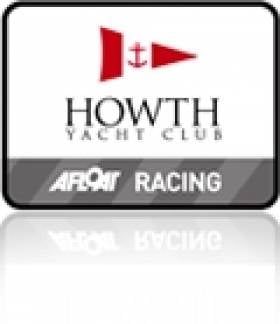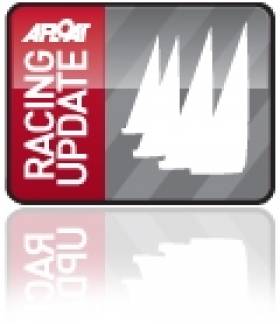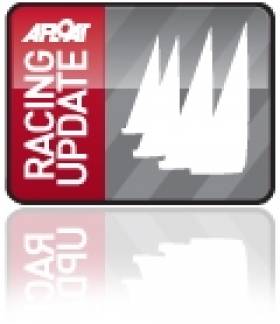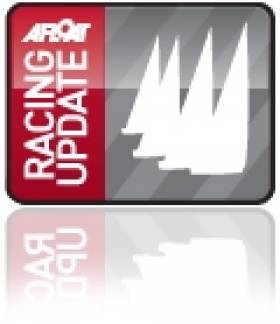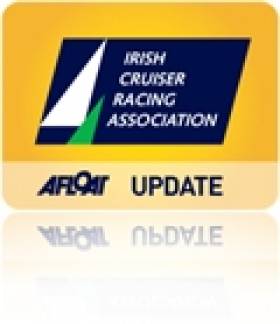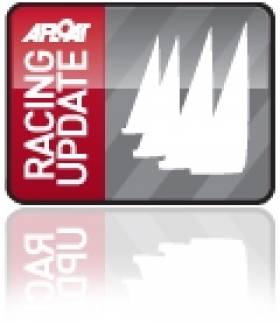Displaying items by tag: Checkmate
Checkmate's Royal Irish Crew Take Race Wins at Key West Race Week 2016
Nigel Biggs’s Checkmate XVI flew the burgee of the Royal Irish Yacht Club at Key West Race Week in mid-January, with a crew including young Irish sailors Adam “Bubbles” Hyland and Cian “Tree” Guilfoyle, alongside Dublin resident Jim Houston. This regatta is a “bucket list” event for sailors all over the globe, attracting Olympic medallists, America's Cup winners and Volvo winners to join professional and Corinthian sailors alike. Is there a better place to sail in January than the Florida Keys writes skipper Nigel Biggs
This was the second instalment of Checkmate’s US tour, following the Annapolis Fall Regatta last October. We joined ten other evenly matched C&C30’s for 5 days of highly competitive windward/ leeward racing where regular place changes were to become the norm. A high scoring regatta is often a testament to close racing, which was this case as this true one design fleet battled for the slightest advantage.
After losing a much needed practice day due to high winds, the first day of racing was a tough one. Starting in 20 knots of breeze that reduced during the day, the waves were up and the water warm for a great day of sailing. Boat handling is vital in any fleet, but when a flogging kite can be the difference between five and fifteen knots, it is crucial. Although happy with our pace, our lack of time in the boat and a couple of breakages meant we struggled to take the results we had hoped for in the first two races. However, we were improving and our efforts were rewarded with a hard earned win in the last race of a long day.
After a long discussion about where we could improve, the boat job list was finished and we headed of for Conch Fritters, Mahi-mahi and Shrimps….with maybe a cold beer.
Tuesday brought big winds, big waves and no racing. After more work on the boat we had a day of sightseeing, swimming and relaxation. The nippers took the opportunity to get up close to the Maxi 72’s and take a dip in a the ocean….slightly more pleasant than the beach at Dalkey in January.
Day three bought a 15 - 18 knots from the NE, an offshore wind that held steady enough to provide the closest racing of the week. With a swell left over from the previous day, it was tough to get upwind without slamming around and kept the fleet close together all day. The first windward mark had 10 of the 11 boat fleet overlapped, but our early start to the day and practice session paid off and we were in the mix all the day.
Finally we got some proper sunshine for day four of racing. Starting in a 10 – 14 knot breeze from the NE, the racing was as close and intense as Wednesday with no room for mistakes. Race 3 of the day had us in the middle of the leading bunch heading for the line, but a slight shift had us heading back in on port….hero to zero in 5 boat lengths!
For the last day of racing we headed out into a torrential downpour, 20 + knots from the south and a monster swell. Just like home – only warmer! After a conservative start at the committee boat, we headed right in a clear lane and were in our element……wind, waves and rain, all very reminiscent of Duna Laoghaire Regatta last summer! With confidence in our boat handling, we worked the boat hard to round the windward mark in first place, hoisted the spinnaker and headed off downwind at speeds approaching 20 knots as the breeze continued to build. Neil Mackley called a perfect lay line for our gybe into the bottom mark and we rounded with a good lead which we extended on the next round to take a thoroughly deserved and applauded win. With the breeze now a solid 25 knots, gusting to 30+, racing was abandoned for the day as we surfed back to the shelter of the dock at 15 knots plus with smiles all round….a great way to end a great week.
Key West Race Week 2016 was certainly very good to us both on and off the water. With a huge range of age and experience on board, we took every opportunity to learn from each other and improve and develop our skills. Our 2 race wins were reward for our efforts (the last being particularly satisfying) and whilst disappointed to only finish 6th out of the 11 competitors in our class, in the no discard series, we will continue to improve.
Our next event is the Miami Ocean Challenge in February where we will continue our 30 year plus Checkmate campaign of working hard, racing harder, but more importantly having fun and making new friends.
Royal Irish C&C 30 Checkmate Racing Stateside
Following the fun we had with our new at Dun Laoghaire Regatta we wanted to race Checkmate XVI in a one-design fleet, so took the decision to ship her to the United States where the class is developing quickly writes Nigel Biggs. With the help of our friends at Hyland Shipping, the boat was shipped to the port of Baltimore and then transported by road to Annapolis where she arrived safely at Bert Jabin’s Yacht Yard on the shores of the stunning Chesapeake Bay.
The guys and girls at Jabin’s were extremely helpful and Checkmate was soon rigged, afloat and awaiting the arrival of the crew which included young Irish sailors Cian Guilfoyle (recent All Ireland winner) and Adam Hyland together with Dublin resident Jimmy Houston and myself (Nigel Biggs) from the Royal Irish Yacht Club.
We arrived a day early, hoping to get some practice in before the racing began, only to find that most of the boats had the same idea so we had a full day of straight line tuning in a steady southerly breeze of around 10 knots, with a couple of short practice races thrown in at the end. It soon became apparent that the boats were extremely evenly matched and that results would be decided by good starts and going the right way, proper one-design racing.
The first race of the Annapolis Fall Regatta was to be 24 miles around the Chesapeake Bay, which included a scoring gate and a points weighting for the second part of the race. Just in case it wasn’t going to be tricky enough finding our way around, the course description referred to passing “through one of the 3 highest spans of the William Preston Lane Jr Memorial Bridge”. Try working out which of the 20 or more spans are the highest from sea level. Add in 15 knots of breeze, lots of commercial ships (both moving and anchored) a downwind start and we felt we had a bit on but at least the sun was shining!
An average start saw us hoist the spinnaker and head off across Chesapeake Bay in cloud of spray, in hot pursuit of the leaders. With everyone struggling to lay the first mark spinnakers were dropped early and we rounded in 2nd . The next leg was an 8 mile beat, against the tide, under the bridge. Maintaining our position in the leading bunch things were looking good until quarter of a mile from the windward mark (and scoring gate) when we found our own little hole and watched the rest of the leading group sail around us, just as happens in Dublin Bay although this fact didn’t help us feel any better about it. We continued around the course in a gradually decreasing breeze, only managing to pick off one boat before the finish where we crossed 5th. A frustrating start but as we kept reminding ourselves, better than being at home in the rain.
The evening’s entertainment included a party launch trip around the bay (courtesy of one of the competing boats owners) which was enjoyed by all, followed by food at a local bar. After a few beers we had soon forgotten our disappointments of the race course and set about doing what we do best, making new friends.
Day 2 began with a shifty 10 knot northerly breeze and warm sunshine, tricky conditions for the 3 planned windward/leeward races. After our early (ish…) night we were keen to make up for the previous days results and started well with a 3rd in the first race of the day. Scoring 4,4 in the next 2 races we returned to the dock in 4th position overall, within reach of 3rd and reasonably satisfied with our days work. Conscious of the fact we were representing the Royal Irish, we considered it our duty to befriend more locals in our new favourite watering the hole, McGarveys Irish Bar, where we sank a few pints and failed miserably to follow the rules of the American Football match being shown on the TV screens. Being fellow athletes, we decided another early night was required, or maybe the time difference was having an effect.
The finally day dawned with more breeze, rain and a lumpy sea so we felt right at home! Unfortunately our early night didn’t seem to have the desired effect and we only managed 5,7 in the days two races, leaving us in 4th overall. On the long motor back to the boatyard the skies cleared and the sun came out, making de-rigging the boat far more pleasant that it would otherwise have been. We attended the prize-giving at the lovely Eastport Yacht Club and after a couple of beers with our new American friends (who’s names really do include Chuck, Randy and Clay) we took the short journey back to Baltimore airport for the return flight home.
We had a fantastic time in our first C&C 30 One-Design event, learnt a huge amount, made new friends (mainly) and are very much looking forward to the next event at Key West in January. Checkmate XVI is now packed up on her trailer ready for the 1200 mile road trip to get her there whilst we are all back at work struggling with jet lag.
I would like to thank everyone who sailed on the boat and all those who helped us along the way and made us feel so welcome, particular thanks going to Clay Deutsch and his team on Just A Friend together with all the staff at Jabin’s Yacht Yard and North Sails whose support was invaluable.
#dlregatta – In a first for Dun Laoghaire Regatta the first C&C30 design in Europe will compete for the overall title at Ireland's biggest regatta this July.
After dominating their class and being crowned top overall boat at the 2013 Dun Laoghaire Regatta, Checkmate Sailing from the Royal Irish Yacht Club are returning to Dublin Bay to defend the title. Their all conquering Humphreys Half Tonner has been replaced with Checkmate XVI, a new C&C30 from the drawing board of Wicklow based designer Mark Mills.
Skipper Nigel Biggs says "Dun Laoghaire Regatta has always been one of our favourite regattas. We have competed here for many years and having been honoured with the top boat award last time, we were determined to come back and try to retain this prestigious award.
During our last project with Checkmate XV we were fortunate to work with Mark Mills who was instrumental in turning a near 30–year–old IOR racer into a competitive IRC boat. Having sold Checkmate XV to our good friend Dave Cullen we were looking for a successor and Mark suggested the new C&C 30 that he had designed.
The boat ticked every box for us, sailed by a relatively small crew, extremely fast, trailable and with the prospect of competitive one-design racing. Checkmate XVI is the first of the class in Europe and although she has only recently arrived from the US we are already finding her extremely rewarding to sail. We are very much looking forward to bringing her to Dun Laoghaire Regatta and catching up with all our friends again
Biggs says 'we have always been made to feel incredibly welcome at this event and feel it strikes the perfect balance between competitive racing and fun socialising. I am extremely privileged to have recently been elected as a member of the Royal Irish Yacht Club and am looking forward to racing under their burgee this year'.
The C&C 30 One Design and offshore-capability and fast sailing performance at an affordable price has picked up the 2015 American SAIL MAGAZINE Best Boat award. See vid below.
{youtube}Vb2na2iwvn8{/youtube}
Promoter C&C in the USA hopes to develop the boat into a high-performance, offshore-capable one-design class that's both easy to sail and affordable compared to other grand prix boats.
The C&C 30 is loaded with go-fast goodies including a centerline sprit pole, a double-spreader carbon-fiber rig, an open transom, an offset companionway, a flush deck, plumb bow, halyard locks (main and jib) and an expansive cockpit.
The C&C 30 is being built in Bristol, Rhode Island.
Famous Half–Tonner Checkmate Gets New Berth At Howth Yacht Club
#checkmateforhowth – The story is that there has been a bit of re-juggling in the Half Tonner lineup at Howth, where Dave Cullen has moved on from the historic King One which once upon a time took the Half–Ton World Cup for the legendary Paul Elvstrom of Denmark, whose Olympic gold medal scoreline is bested only by Ben Ainslie.
The good news is that King One is going to continue to sail the waters of fair Fingal. She now has a Rush-based owner, who plans to continue to keep her at Howth where they've a handy little group of classic Half Tonners sharpening up for 2015.
And a further welcome word is that Dave Cullen himself will be returning to the fray, having taken over Nigel Biggs' all-conquering Half Tonner Checkmate. This little honey has had so much TLC and classy mods made in recent years that 'tis said a statement had to be issued saying the boat is NOT called Cheque Mate...........
#halftonclasics – Stunning, is the best way to describe the opening day of the 2014 Half Ton Classics Cup in Saint-Quay-Portriuex on the north coast of Brittany writes Fiona Brown. The weather offered something for everyone including plenty of sunshine and a range of wind conditions, the race management provided three great windward leeward races, and the Half Tonners and their crews excelled themselves by providing seat of the pants racing all day.
It is clear that the level of competition in the 22-strong fleet has taken a significant leap forward this year. After racing Richard Hollis of Crakajax, an X-95 production Half Tonner from Cowes, which has competed in many of the Half Ton Classics events, noted; "It's much tougher this year. The racing is extremely close. Just one small mistake and you loose several places. The quality of the sailing in outstanding." This was borne out by the results where the boats were frequently separated by mere seconds on corrected time and a different boat won each race. Race one went to Francis Marshall's 1989 Andrieu designed Concord, race two to Bernard Fournier Le Ray's Brittany Drizzel, a 1978 Berrett design, and race three to Peter Morton's beautifully refitted 1977 Farr designed Swuzzlebubble.
With three races completed fleet newcomer Peter Morton, better known as the man who revived the Quarter Tonners and who won his fourth revived Quarter Ton Cup just a fortnight ago, is leading the fleet. Swuzzlebubble is something of a legend among Half Tonners and this is her first serious outing at a Half Ton Classics event. Despite being the new kids on the block Peter and his very experienced crew laid down a 2, 2, 1 score as they found their feet in the boat. Two points behind in second place overall is Bernard Fournier Le Ray's Brittany Drizzle, which has achieved great success in her home port of La Trinite. In third place overall on 20 points is the 1980 Joubert-Nivelt designed Sibelius, owned by Claude Charbonnier who is also based in La Trinite and is another regular on the Half Ton circuit. Philippe Pilate's General Tapioca (1978 Jean Berret) is in fourth place with 21 points and Toni Stoschek's Superhero (1988 Andrieu), Nigel Biggs' Checkmate XV (1985 Humphries) and David Evans' Hullaballoo XV are all tied for fifth on 23 points. Hullaballoo XV is a 1978 Stephen Jones designed Hustler 32 and as such she is also the leading boat in the Series Division for production Half Tonners.
The different race winners also represented very different approaches to Half Ton campaigning. Whilst all the boats in the fleet are immaculately maintained there are some who take a strictly traditional approach, retaining their runners and checkstays and keeping their deck layouts as original, while others choose to modernise the boats as much as is possible within the confines of the strict class rules.
Winner of race one Francis Marshall is definitely an owner who takes a classic approach in regard to Concord, his carbon composite and full titanium Half Tonner which he campaigns with a bunch of Enterprise dinghy sailing friends from Loo in Cornwall. When Francis purchased Concord in 2008 she had been fitted with a small swept back spreader rig and much of the original titanium had been removed. Francis painstakingly restored the entire boat including replacing all the titanium and she is now in perfect as original condition. Their win in today's first race was a nice book end moment for Francis and Concord as they also won the final race of the 2011 Half Ton Classics Cup in Cowes, which was her last serious racing outing. Francis explained; "Concord has been in a lorry park so she hasn't been sailed since Cowes. We launched her in Plymouth about a month ago and sailed four Wednesday nights in training for this, although we didn't quite manage to get all the crew on the boat at the same time until we came here. So we were quite pleased with that first race and it all came together well!"
Swuzzelbubble represents the opposite end of the refit spectrum and has been extensively optimised for IRC with a swept back spreader rig and a fully modernised deck layout. Rob Lark, tactician aboard Swuzzlebubble, acknowledged that the boats with a more modern rig and deck layout do have some advantages, particularly in close tacking duels when the need for extra time to change runners can make all the difference to a boat, as Brittany Drizzle, who retains her runners and checks, found out when they engaged in a tacking duel with Swuzzlebubble on the second beat of race two.
This evening the crews enjoyed a rousing prize giving in the Half Ton Classics Cup Regatta Marquee, cheering loudly for each boat as their name and finish position in the racing was called out. The three race winners were called to the podium and presented with specially engraved Harken winch handles.
Tomorrow the boats will take part in a short offshore race starting at 10.00 that will take them around l'Ile de Brehat, a stunningly beautiful archipelago of pink granite islands that lie a mile off the Brittany coast and some 25 miles to the north west of Saint-Quay-Portrieux. The regatta continues until Friday.
#halfton – As well as defending Royal St. George YC champion Checkmate XV (Nigel Biggs), Ireland will send at least three more potent Half Tonners to the Classics Cup in France in two months time. Currently confirmed entries are Dave Cullen's King One and the Evans' brothers 'Big Picture' having just completed a major optimisation both from Howth with Harmony and George Radley's new boat from Kinsale yet to confirm.
The growing interest in the class is breathing life back into old boats that can be bought for as little as €5,000 and their ability to be towed is also seen as a great benefit.
While the Half Ton Classic Cup is raced on IRC and this is the prize the top boats have in their sights, the "Half Ton True Spirit" prize is regarded by many as the top prize and last year was won by a boat that had no optimisation whatsoever".
The entry list is expanding rapidly for the Half Ton Classics Cup which will be held at Saint Quay Portreiux in Northern Brittany from 7 to 11 July 2014. More than 30 teams are expected to attend, and this 7th edition of the regatta is anticipating a bumper turnout including many of the best known boats and sailors in the class.
Launched in 2003, the Half Ton Classics Cup led the way for the revival of the IOR Classes and its philosophy has helped to ensure that most boats remain as close to their original designs as possible.
This year the HTCC regatta will be a true European championship for small IRC rated boats, with all the top French and UK halftonners on the starting line.
With two weeks to go until the initial entry closing date of 31st May 2014, the Entry List alread includes some 25 boats with additional entries being added regularly. Among the well known names competing this year are past Half Ton Classics Cup winners General Tapioca, Chimp and Checkmate XV. There will also be several new faces at the event including Peter Morton, better known to many as the man behind the Quarter Ton Cup revival, who will be racing his IRC optimised Half Tonner Swuzzlebubble.
The regatta will be hosted by the Sport Nautique de Saint Quay Portrieux in collaboration with the Bruxelles Royal Yacht Club and the Half Ton Class Europe. Registration will open on Sunday 6 July, there will be practise racing on Monday 7 July and Championship racing will take place from Tuesday 8 to Friday 11 July.
#checkmate – Following a number of delays on the long road journey, Checkmate XV from the Royal St George Yacht Club finally arrived in Marseille in the early hours of Friday, the first day of racing. Having arranged launching with Corbieres Port Services at 8 am (thank goodness for email and google translate!) we managed to get the boat launched, rig stepped and motored across to Vieux Port arriving shortly before midday. After a quick sort out we managed to fasten enough fittings on to enable us to go sailing and headed of for the race area and the first start at 2pm.
The only race of the day was sailed in a gusty 15-20 knot breeze and we were delighted to return ashore, having kept the mast pointing upwards all day, to find we had managed 5th in our class of 22. Feeling very pleased with ourselves after not sailing for over 7 months and with much work still to do complete various systems onboard, we retired for an early night to catch up on much needed sleep.
Daylight the next morning saw Matt down at the boat early armed with Sikaflex and his tools to begin working his way through the job list. All the crew joined him and good progress was made before it was time to leave the dock for the race area again and the first start at 11. Three races were sailed in slightly less breeze than the previous day but this time with the benefit of warm sunshine. The starts were extremely competitive with a number of general recalls, the PRO eventually reaching for his black flag and being the lowest rating boat in the fleet we seemed to have company all the way around the race course. Whilst our boat handling was rusty we managed to keep out of too much trouble and returned ashore exhausted after 6pm having scored 3, 7, 9 for the day.
Refusing a beer, Matt got straight into the job list again and was last seen disappearing under the cockpit, tooled up, with his headlamp on, finally re-appearing in time to join us all for a late beer before bedtime.
The final day started the way all the others had, lots of activity on the boat as systems were altered and fittings added, until it was time to leave the dock. Warm sunshine again and a light breeze made it seem more like a summers day than the beginning of April and the PRO soon got into sequence. After another general recall we finally got away on a coastal race which was rather like a lucky dip for us at every mark as we had forgotten to take the SI's with us in our haste to make the start! Undeterred and benefitting from having boats to follow, we spent 2 hours sailing up and down the stunning coastline south of Marseille before the race appeared to be abandoned. Dropping our spinnaker we joined the rest of the fleet whilst the PRO waited for the new breeze to settle and eventually the final race was started.
We returned ashore to find we had scored 2nd in the final race only to be recorded as DNF in the first one of the day, a lesson if ever we needed one, on the importance of having the course information onboard. Short on time, as ever, for making our flights, we were fortunate enough to have the Jenson Button of taxi drivers who managed to get us to the airport on time.
Reflecting on the weekend we learnt (or should that be reminded ourselves of) a number of valuable lessons:
Make sure the boat is finished before leaving base.
Make sure the boat arrives on time.
Remember to take the little black box that makes the computers work.
When you only have boat speed and heading, don't throw this one remaining instrument display into the sea as it doesn't float.
Don't forget to take the SI's, particularly if you don't speak the local language, our DNF relegated us to 5th for the regatta from the 3rd we would have finished....
Despite all this we very much enjoyed our visit to Marseille and look forward to returning again for the SNIM event at Easter. In the meantime we would like to thank John Corby for the fantastic job he and his team did rebuilding CXV (again!) and Matt for his efforts in ensuring we were able to get on the water.
ICRA Nationals 2014 Will See Duel of Vintage Half–Tonners
#halftonner – In what is being billed as the 'Duel of the Half Tonners' by ICRA organisers for June's National Championships another vintage half–tonner 'The Big Picture' is being optimised for competition. According to ICRA Commodore Norbert Reilly, the Howth campaign plans to take on the Nigel Biggs Sistership MG30, the all conquering ICRA National Champion, Check Mate IV.
Though, currently for sale on Afloat.ie, there is also the prosect of a three way half ton battle with Dave Cullen's King One, a boat that has taken its own share of silverware.
Commodore Reilly's own boat, Crazy Horse is at Malahide marina boatyard to sort out damage sustained at last year's Volvo Dun Laoghaire regatta Week.
The overall leader of the 2013 event was forced out after a collision with J109 clubmate, Storm. Both boats were doing seven knots at the time of the incident.
His Cruisers Zero crew is preparing for the nationals as part of the Howth YC Team and mounting a bid to win the Club Championship Trophy currently held by Royal Irish YC.
Reilly has hinted that former crew mates David Harte and Led Pritchard (both ex Comanche Raider crew) will join the boat.
Half Tonner Checkmate Wins Classic Cup in Boulogne Sur Mer
#halftoncup – The Half Ton Classic Cup in Boulogne Sur Mer was convincingly won by July's Dun Laoghaire Volvo regatta winner, Checkmate (Nigel Biggs) sailing under the Royal St. George Yacht Club burgee with a succession of race wins.
Recently W M Nixon followed the winding path which has led through various attempts at creating offshore one designs into the success of the Ton Cup categories, and their recent revival as classics using the IRC handicap system - just like everyone else.
Also competing in France was Howth Yacht Club's King One. Having broken her mast in Cowes in the last event when leading the pack, there was a greater enthusiasm to return to the fleet with a bang. Winds varied from 5 to 20 knots during the week with glorious sunshine and temperatures except for a gloomy wet grey day on the Thursday of the event.
Lying a solid fourth in the 28–boat fleet on the Wednesday evening, this gloom extended to King One when they were black flagged on the double point non discardable offshore which put pay to any chance of a decent overall result. Ironically, the boat that pushed King One over the line at the start also was disqualified for being over.




























